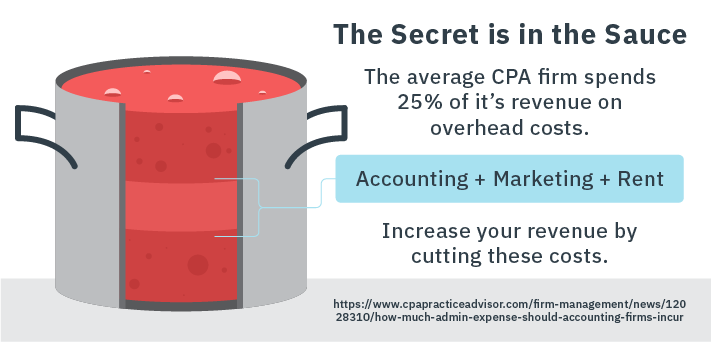As a CPA (Certified Public Accountant), you are used to being under pressure. Tax deadlines, client mergers, and audits are all just part of the job.
But when it comes to your own firm's profitability, it can be easy to look the other way. Bury your head in the metaphorical sand.
Here's the thing — the accounting world is changing. The way things have always been done is no longer the path to success. Ever-growing competition, the rise of AI, automation, and the gig economy have made it harder than ever to maintain profits.
In this ever-changing climate, how can you improve the profitability of your firm? Do you double down and find more clients? Shift your niche? Offer a broader range of services?
What if I told you there was a way to increase CPA firm profits by doing less?

Before looking at strategies to increase profitability, we first need to consider the challenges of calculating CPA profitability and how that impacts the most effective strategies.
What are the challenges when calculating CPA firm profitability?
Given the fact that CPAs are masters of financial data, you would think that calculating profitability would be a simple affair. In fact, it is anything but.
Unlike product-based business, service-based businesses, like CPAs, have complex profitability measures. While the owner of a local retail store can get an accurate view of profits by subtracting overhead and expenses from sales, as a CPA firm, you have far more numbers to juggle.
Net profit margin (the net income as a percentage of net revenue) is often considered the gold standard for measuring CPA firm profitability. However, there are many variables that firms must consider when calculating this, including:
- Revenue per partner
- Revenue per person
- Staff-to-partner ratio
- Partner billing rate
This mix of measurements can bury the true value of certain strategies and make calculating effectiveness more difficult.
Despite these challenges, CPA firms can still be highly profitable. However, many firms are feeling the crunch as software solutions and increased competition put pressure on profit margins. What is the solution? Sometimes, doing less might be the answer.

How to increase your accounting firm profit margin
On the surface, the easiest way to increase CPA profitability is simply to increase your rates or bring on more clients. However, that approach may not be as viable in a time where AI and automation are disrupting nearly every industry.
While raising rates or acquiring more clients can certainly contribute to increased profitability, it is important for CPA firms to consider the long-term implications of these strategies. With the rise of AI and automation, many routine tasks that were once performed by CPAs can now be automated, leading to a decrease in demand for traditional accounting services.
Instead of solely relying on rate increases or client acquisition, CPA firms should focus on adding value to their services in order to differentiate themselves from automated solutions. This can be achieved by offering specialized expertise or niche services that require human judgment and critical thinking.
Instead of doing more, consider the following strategies to increase your CPA firm's profitability.
Eliminate low-value services
Instead of raising prices, consider spending more time focusing on more profitable services. Tasks like bookkeeping can eat up valuable time without offering a high profit. Evaluate each service you offer and divide it by the full amount of time your firm spends completing that task.
You may notice certain tasks take far more time than you realized — and that could be eating into your profit margins. Look for ways to eliminate or outsource those services so you can focus on high-earning services.
Be mindful of eliminating stepping-stone services that can attract larger. Instead, find ways to streamline or automate portions of those services so you can offer more services while spending less time on time-consuming manual tasks.
Reduce operating inefficiencies
Money wasted on operating inefficiencies could be spent on better staff, more technology, or even a higher profit. Reconsider the tools you use, the processes you've built, and how you communicate with coworkers and clients.
Think you don't have any operating inefficiencies? You might not be looking hard enough.
Is there a more efficient way to store your data? Could you eliminate or automate steps in your workflow? Even just saving a few minutes of time on a single process could save thousands of dollars for tasks you complete on a regular basis.
Move to a value-based pricing model
Many CPA firms still rely on an hourly pricing model, where rates are based on how long tasks take. However, this traditional pricing model can create additional work for CPAs as they are forced to meticulously account for every moment of their day. Moreover, it can make it challenging to provide clients with accurate quotes for services.
In contrast, a value-based pricing model charges based on the amount of value your firm provides to clients. This approach shifts the focus from the number of hours spent on a task to the outcomes and benefits the client receives. It creates a more effective selling process because, ultimately, clients are not concerned with how many hours you spend on a particular task. What they truly care about is what they gain from your services.
Upsell existing clients
Instead of focusing solely on bringing in new clients, which can require a significant time investment upfront, consider exploring ways to increase profits by offering additional services to your existing clients.
For instance, if your firm currently provides tax services or other one-off services, you can try upselling ongoing services such as payroll, auditing, or management consulting. By doing so, you not only deepen your relationship with your clients but also create opportunities for recurring revenue streams.
Upselling existing clients can be a more efficient and cost-effective strategy compared to constantly seeking new clients. It allows you to leverage the trust and rapport you have already established, making it easier to showcase the value and benefits of the additional services you offer. This approach also saves time on marketing and acquiring new clients, as you are building on an existing foundation.
Make sure new clients are right for you
In some cases, it makes sense to upsell current customers. But when your current customers are high-maintenance, it may make more sense to bring on new clients instead.
Focus on finding new clients that are organized and proactive. These clients can increase profitability because they take up less of your time — particularly if you move to a value-based pricing model versus a per-hourly model.
When your current customers require a significant amount of hand-holding and constant attention, it can be a drain on your firm's resources. Although upselling may seem like the logical choice, it may not always be the most profitable option. Instead, redirect your efforts towards acquiring new clients who are more self-sufficient and proactive in their engagement with your firm.
By focusing on finding clients who are organized and proactive, you can ensure that they require less hand-holding and constant attention. This allows you to allocate more time and resources to providing value-added services rather than spending excessive amounts of time resolving issues or addressing constant inquiries from high-maintenance clients.
Offer staff education benefits
A highly educated staff can have a long-term impact on CPA firm profitability. Consider offering employees a match or grant to pursue secondary education or certifications.
Worried about the cost? Paying for employee education can save your firm money. Cigna, a worldwide health organization, saw a return of $1.29 for every dollar they spent on employee education. The staff that used Cigna's education benefits were more likely to stay and be promoted, saving the company on hiring costs.
A knowledgeable staff may also allow you to expand your client base into new niches, increasing overall profits.
Reduce billing and accounting costs
According to the Rosenberg Survey, the average CPA firm spends 25% of its revenue on overhead costs such as accounting, marketing, and rent. Reducing these costs can increase your revenue by cutting costs rather than increasing billing.
For example, using AI billing software can decrease billing costs by allowing you to:
- Streamline the billing workflow process
- Gain access to data that makes billing easier
- Get better insights into the work going on in your firm
- Automate billing reminders
- Eliminate paper billing processes
Invest in tech
In today's world of Silicon Valley startups and SaaS (Software as a Service) -businesses, investing in tech is no longer an option - it is a necessity. If you want to compete with other firms and online services, accounting firms must invest in tech to reduce overhead costs and increase overall productivity.
For example, meeting management software can help firms better use their space and reduce the time employees spend planning meetings. Visitor management software can increase security while streamlining the reception process. Cloud document storage can make it easier than ever to organize and access documents, saving time and increasing security at the same time.
Don't feel like you have to have every new thing; instead, carefully consider how a new solution could save your firm time or increase profits before diving in.
Conclusion - pick your battles when improving profitability
In order for accounting firms to maintain profitability, they must be willing to challenge the status quo and embrace change. If traditional practices are no longer effective, it's time to take a different approach. The good news is that this doesn't mean working longer hours. Instead, it involves eliminating unprofitable services and clients, while leveraging technology to automate manual tasks.




